As an architect, you’re no stranger to the intricacies and complexities of the design and construction process. Amidst the juggling of blueprints, permits, client expectations, and a multitude of other tasks, one essential acronym takes center stage: RFI, or Request for Information.
Using contract administration software such as RForm to manage RFIs streamlines architectural projects and removes many of the most common issues that contractors and other stakeholders run into with them. However, it is still vitally important to understand the function and necessity of RFIs, because when they aren’t responded to in a prompt manner they can cause issues or lead to delays in a project.
What is an RFI?
To put it simply, an RFI, or Request for Information, is a crucial communication tool in the construction industry. It serves as a formal written request from the contractor or builder to an architect or consultant, seeking clarification, additional details, or explanations about various aspects of the project.

An RFI may come from various stakeholders within the project but most often from the contractors, subcontractors, or even the client themselves. This request is typically prompted by ambiguities or gaps in the project documentation, such as plans, specifications, or contracts.
Why are RFIs Necessary?
You might be wondering why RFIs are even necessary in the first place, especially when extensive planning goes into the initial project documentation. Here’s why they are indispensable:
1. Clarification: Despite meticulous planning, misunderstandings can occur. RFIs provide a platform to seek clarification on design intent, materials, or any other element of the project.
2. Resolving Ambiguities: Blueprints and specifications can sometimes leave room for interpretation. RFIs help eliminate ambiguity by asking for specific details or instructions.
3. Cost Control: RFIs can also address potential discrepancies in the budget, helping to avoid unexpected expenses by seeking clarification on cost-related matters.
4. Compliance: Architects must ensure that the project adheres to local building codes and regulations. RFIs can be used to confirm compliance and request any necessary adjustments.
5. Quality Assurance: By seeking clarification and providing detailed instructions, RFIs contribute to the overall quality of the project, ensuring it meets the desired standards.
An example of an RFI might be the Contractor requesting clarification on some missing dimension on a drawing, or one that is common and some times leads to additional costs is if a construction detail is missing and direction on how to build it is required.
However, you need to be sure that a formal process in exists in your contract for creating RFIs and that there are some pitfalls to be aware of as pointed out by the OAA in a practise advisory – “Don’t fall into the RFI trap” if you are responding to an RFI.

The Anatomy of an RFI
Now that you understand the importance of RFIs let’s break down what one typically comprises:
1. Title: The RFI usually begins with a clear and concise title that describes the subject or purpose of the request.
2. Introduction: This section provides an overview of the RFI, including the project name, date, issuer’s information, and the recipient’s details.
3. Description: At the heart of the RFI, this section outlines the specific questions or concerns. It’s essential to be clear and concise, providing context and referring to relevant project documents whenever possible.
4. Supporting Documentation: If necessary, you can attach drawings, plans, or specifications to help illustrate your questions or concerns.
5. Requested Response: Clearly state what you expect in response to the RFI. This may include revised drawings or detailed explanations.
6. Deadline: Specify the deadline for the response to ensure timely communication and progress on the project.
7. Contact Information: Include your contact details in case the recipient needs further clarification.
The RFI Process
Now that you know what an RFI is composed of, let’s walk through the typical process of how RFIs are handled:
1. Issuing an RFI: When the contractor or other stakeholder identifies a need for clarification or information, they draft an RFI. It’s then sent to the relevant party, such as an architect or consulting engineer.
2. Review and Response: The recipient reviews the RFI and gathers any necessary information. They may consult with other team members or experts to provide a comprehensive response.
3. Timely Response: Meeting the specified deadline is crucial. Delays in responding to RFIs can lead to project setbacks or misunderstandings.
4. Communication: Often, the RFI process involves back-and-forth communication. The issuer may need to ask follow-up questions or request additional information based on the response received.
5. Documentation: All RFIs and their responses should be documented and stored for future reference. This documentation is essential for maintaining a clear project history and addressing disputes if they arise.
6. Implementation: Once the RFI has been addressed and resolved, the necessary actions, such as updating project plans or adjusting the budget, can be taken.
In the world of architecture, RFIs play a pivotal role in ensuring the smooth progression of projects. By embracing the RFI process and using it effectively, you can enhance communication, clarify project details, and ultimately contribute to the success of your projects.
Efficient workflow processes are fundamental to achieving successful project outcomes. The responsibility for this efficiency rests on the shoulders of architects, construction professionals, project managers, and contract administrators. Keep in mind however that regardless of the software you are using, you will still need to address the issue itself in a timely manner.
RForm’s Request For Information (RFI) feature is purpose-built to simplify and elevate your construction contract administration. It’s designed to empower you with a streamlined and enhanced experience, ensuring that RFIs no longer hinder your construction projects. Contact us now for a free 30 day free trial or schedule an RForm demo now to learn how much easier it makes contract administration for your office.

